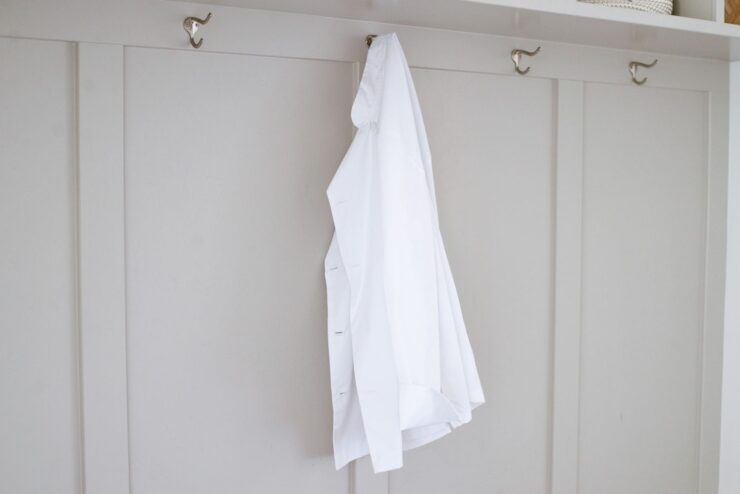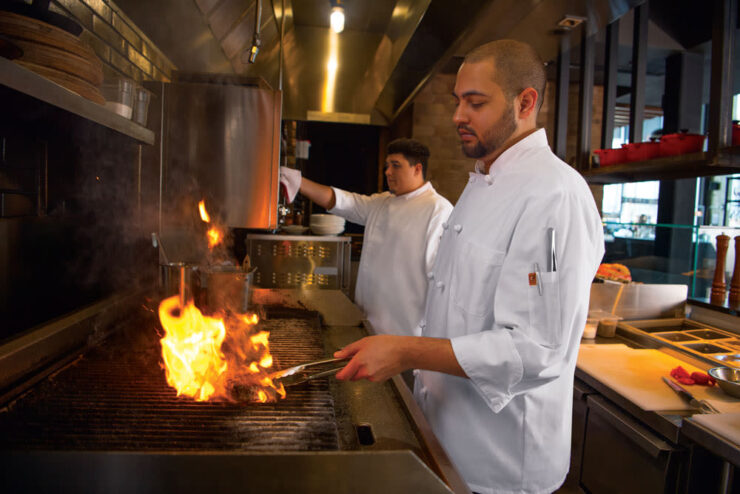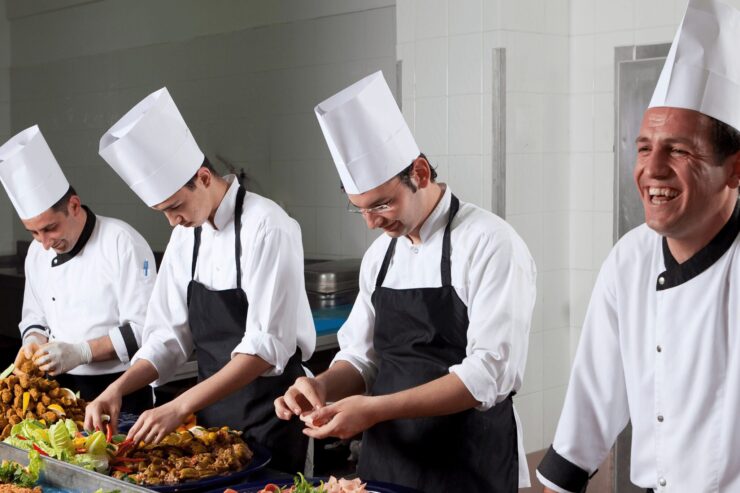A chef’s coat is not an ordinary garment. It is iconic and represents professionalism and expertise in the culinary world. Proper maintenance of your chef coat is essential not only for hygiene but also for projecting a professional image and extending its lifespan.
This laundry blog will guide you through proper chef coat maintenance. It is our pleasure to help you ensure your wardrobe remains clean, presentable, and durable.
Understanding Chef Coat Fabrics
Chef coats come in various fabric options, such as cotton, polyester, or blends. Understanding the different fabric types is crucial for choosing appropriate care methods.
Cotton chef coats are breathable and comfortable but tend to wrinkle more easily. On the other hand, polyester and blends are known for their durability and resistance to stains.
Consider the pros and cons of each fabric type when selecting your chef coat and determining the best care practices.
How to Prepare Chef Coats for Washing

A common laundry mistake when washing is disregarding the preparation stage. It is important to check your chef coat and read its wash label to ensure you wash them correctly.
For grease stains, sprinkle some baking soda or cornstarch on the affected area and let it sit for a few minutes before brushing it off.
Empty all pockets and remove any loose items, such as pens or thermometers, to prevent damage during the wash.
Washing Techniques
When washing chef coats, there are two primary methods: machine washing and hand washing.
Machine washing is suitable for most chef coats unless specified otherwise. Select a gentle cycle and use cold or warm water, depending on the fabric’s care instructions. Avoid using bleach or strong detergents that may damage the fabric or affect the color.
Meanwhile, fill a basin or sink with lukewarm water and mild detergent for hand washing. Gently agitate the chef coat and rinse thoroughly.
Drying and Ironing
After washing, proper drying techniques are crucial to maintain the shape and quality of your chef coat. While air drying is ideal, use a tumble dryer on low heat if necessary. Avoid high temperatures that can cause shrinkage or damage to the fabric. Remove the chef coat from the dryer promptly to minimize wrinkles and fold or hang it immediately to prevent creases.
Ironing is often necessary to achieve a crisp and professional appearance. Set the iron to the appropriate temperature based on the fabric’s care instructions. Use steam or a damp cloth to remove stubborn wrinkles, and iron gently in a back-and-forth motion. Pay extra attention to the collar, cuffs, and front placket for a polished look.
Stain Removal Tips

Chef coats are prone to stains from various ingredients used in the kitchen. To tackle common stains effectively, consider the following tips:
For oil or grease stains, apply a small amount of dishwashing liquid or a specialized stain remover directly to the stain. Gently rub the fabric together to work in the detergent before washing.
Wine stains can be treated by blotting the area with a clean cloth or paper towel to absorb excess liquid. Then, apply equal parts of hydrogen peroxide and liquid dish soap to the stain. Let it sit for a few minutes before washing.
Food coloring stains require immediate attention. Rinse the stain with cold water to remove as much color as possible. Then, treat the area with vinegar and water before washing.
Storage and Maintenance
Proper storage and maintenance between uses are crucial in keeping your chef coat in top condition. Hang your chef coat on a sturdy, wide hanger to maintain its shape and prevent wrinkles. Avoid overcrowding in the closet to prevent crushing or creasing.
If your chef coat requires spot cleaning between washes, use a mild detergent and a soft cloth to remove stains or debris gently. Additionally, consider using fabric fresheners or sachets to keep it smelling fresh.
Extending the Lifespan of Chef Coats

Incorporate these additional tips into your maintenance routine to maximize the lifespan of your chef coat.
- Avoid exposing your chef coat to harsh chemicals or bleach, as they can weaken the fabric and affect the color.
- Handle your chef coat carefully, especially around open flames or hot surfaces, to prevent burns or damage.
- Regularly inspect the chef coat for loose buttons, loose threads, or any signs of wear. Repair or replace these elements promptly to avoid further damage.
Follow the Proper Maintenance for Your Chef Coat
Proper chef coat maintenance is essential for maintaining hygiene standards, projecting professionalism, and extending the lifespan of this iconic garment. By understanding the fabric, preparing the coat for washing, following proper washing and drying techniques, and employing effective stain removal methods, you can keep your chef coat clean, presentable, and durable. Store it promptly and adequately address maintenance issues to ensure your chef coat serves you well throughout your culinary journey.
However, it can’t be helped that we can get busy. There’s no shame in asking for help. You can find the nearest Laundry Luna laundromat and get your chef coat cleaned and maintained.
Cleaning Tips

Stain removal is an inevitable part of chef coat maintenance. Despite taking precautions, stains are bound to occur in the kitchen. Here are some additional tips to effectively remove stubborn stains and keep your chef coat looking its best.
For tomato-based stains, apply a small amount of dishwashing liquid directly to the stain and gently rub it in. Let it sit for a few minutes before washing. If the stain persists, create a mixture of equal parts vinegar and water and dab it onto the stain. Rinse thoroughly and wash as usual.
Coffee or tea stains can be treated by blotting the area with a cloth soaked in cold water. Then, apply a mixture of vinegar and water to the stain and gently rub it in. Rinse well and launder the chef coat.
To tackle stubborn wine stains, sprinkle salt on the affected area to absorb excess liquid. Rinse with cold water and apply a mixture of equal parts hydrogen peroxide and liquid dish soap. Let it sit for a few minutes before washing.
For tough grease stains, create a paste using baking soda and water and apply it to the stain. Gently rub the fabric together to work in the paste, and then wash as usual.
Remember to always check the fabric care instructions and test any stain removal method on a small, inconspicuous area of the chef coat before applying it to the stain directly.
In addition to stain removal, proper storage and maintenance are key to prolonging the lifespan of your chef coat. Avoid storing it in damp or humid areas, as this can lead to mold or mildew growth. If your chef coat is heavily soiled, consider professional dry cleaning to ensure thorough cleaning without damaging the fabric.
By following these tips for proper chef coat maintenance, you can ensure that your iconic garment remains clean, presentable, and durable throughout your culinary journey.

